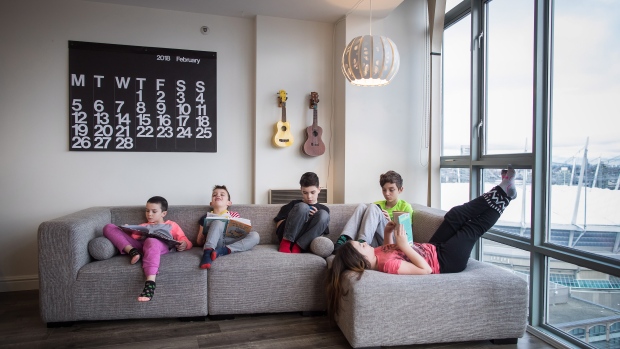VANCOUVER — Adrian Crook hadn’t always intended on raising his five kids in a three-bedroom condo in downtown Vancouver.
But skyrocketing real estate and rental markets across much of the country have some families choosing small spaces over suburban sprawl — and finding unexpected benefits.
Crook moved downtown from the suburbs following a divorce, craving the social connections that he says are more readily available in the city.
Now his family of six lives in a 1,000-square-foot condo in the heart of Vancouver, which Crook says allows them to live a healthier, more sustainable lifestyle and gives him more time with the kids, aged 5, 7, 9, 10 and 11.
Living small has required some creativity, including custom bunk beds in a room shared by the three boys, but he says it also allows the family to easily walk to parks, galleries and libraries and teaches the kids about diversity that they may not see in the suburbs.
“They get a much more fulsome impression of the world and the possibilities. And hopefully develop empathy in ways that they might not if everyone was the same as them,” says the tech entrepreneur.
Crook, who is running in Vancouver’s fall election, says people have a mistaken idea that kids need a lot of space.
“They really want you around and you to love them as much as possible, first and foremost,” he says. “And then they want creative, flexible things to do. They want to be left to their imaginations as much as possible and not have you control their reality.”
Canadians are increasingly shifting to smaller living. The number of people living in apartments taller than five stories went up more than 12 per cent between the 2011 and 2016 census, according to data from Statistics Canada.
The change was particularly noticeable in B.C. where the number of people living in single-detached homes dropped by 1.4 per cent, while the number of people living in apartments taller than five storeys went up by more than 23 per cent.
People outside of hot real estate markets are choosing to live small, too, including artist Shelley Vanderbyl, who lives with her husband and their three kids in a 950-square-foot home in Winnipeg.
Living small was never the plan, Vanderbyl says, but it’s worked for the family, which includes a 15-month-old, a three-year-old and a six-year-old.
“My kids have always grown up in this space. It doesn’t feel small to them. You sort of just get used to it,” she says.
It also teaches children problem solving, creativity and conflict resolution, Vanderbyl adds.
“If you’re angry at someone, you can’t go somewhere and be away from them. You’ve got to sort it out. You just decide that you’re going to get along,” she says.
A small floor plan does require flexibility, Vanderbyl says. Her family has learned to use every room for a variety of purposes and to move people and objects around as needed.
Sometimes the results are non-traditional, but she notes that the expectation for families to have large, spacious homes is relatively new and doesn’t exist in many places outside of North America.
“I think you have to let go of expectations and not feel guilty if your baby sleeps in a play pen because it’s smaller than the square footage of a crib or it’s on wheels and rolls better,” Vanderbyl says.
“You just do what your family needs to do and what feels right for you.”
Minimalism is also key to small living, says freelance writer Emily Morrice, whose family of five lives in a 1,000-square-foot, two-bedroom condo in downtown Montreal.
Constant de-cluttering is necessary, as is saying no to people who want to buy the kids presents, she says, which can be difficult.
“You have to be careful about that,” she says. “Or once you let new stuff in, you have to be willing to send things out.”
The family asks for memberships to museums or for activities like swimming lessons instead of toys or clothes for Christmas and birthdays, she says, and the three kids — aged seven, six and four — have become experts at sharing.
All three share a room with bunk beds and a pull-out mattress and abide by an important house rule: The first day someone gets a toy, it’s theirs, but every day thereafter, it’s shared, Morrice explains.
She says the kids have a uniquely close bond as a result.
“I wouldn’t say that we chose to have a small home in the beginning. We chose to live in the city and that necessitates a small home,” says Morrice, who chronicles her family’s experience on her blog, Our Nest in the City.
“But we’ve been parents in a small home for eight years and I would never want anything else. It’s just so great for the family and the kids.”




 Driving Naari Programme launched in Chandigarh
Driving Naari Programme launched in Chandigarh































